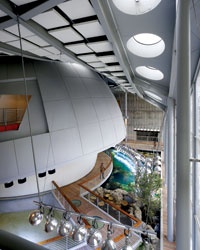 Tim Griffith
Tim Griffith
The Just-opened California Academy of Sciences (55 Music Concourse Dr.; 415/379-8000; calacademy.org ), in San Francisco’s Golden Gate Park, extends green, sustainable architecture in unprecedented ways. Pritzker laureate Renzo Piano’s airy, luminous building replaces the original 150-year-old San Francisco institution, damaged in the 1989 earthquake, but preserves an original Neoclassical limestone façade from the beloved African Hall (where South African penguins now cavort) within a sleek glass-and-concrete building. The innovative plan combines energy-efficient technology—a “living roof” of native California plants provides the building with natural insulation and prevents 3 million gallons of rainwater runoff annually—with state-of-the-art exhibitions. The largest of the seven undulating “hills” on the roof form the skylight-studded tops of two 90-foot domes. One houses the biggest all-digital planetarium in the world, which employs real-time data from NASA to show spectators cosmic events as they take place in space. Under the other, visitors explore rain-forest habitats, from the canopy (butterflies, macaws, and fruit bats) down to ponds filled with fish (piranhas and electric eels) from the Amazon. The watery world is a centerpiece of the Academy’s Steinhart Aquarium, which now contains a wave-shaped tank wall filled with exotic sea creatures. Piano has also recast other elements of the original Academy, including coffered ceilings and the former aquarium’s Doric colonnade—seamlessly integrating the museum’s past and its earth-friendly future.